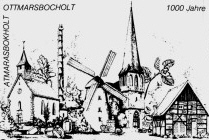Ottmarsbocholt /Ascheberg

Unbill 1375 Wepelinch belonged to the Prämonstratensen Monastery, founded in 1121 by the Earls of Kappenberg on their family grounds. It is possible that a document from 1295 (without mention of the parish though) refers to the farm. In this year, the Knight G. von Meinhövel transfers to the Monastery certain parcels of land once owned by a certain Henricus Hovinc, and adjacent to the Wepelinch farm. In view of the concentration of properties in the proximity of the Monastery, the above property was exchanged to the Benedictine Abbey in Werden on the Ruhr in 1375, admittedly too far away to supervise. In 1413 Wepeling was enfeoffed to Bertold de Hert. *2
Weppelman(n) Farm in the 19th Century Ottmarsbocholt |
Weppelman(n) Farm in 1999, Ottmarsbocholt |
The adjacent farm * „ Baumeister „ belonged to the House of Rensich, (Romberg, ca. 1590), but was cultivated by a „ Weppel colit „ i.e. cultivated by a Weppelmann. *3 This means that at the time Hof Weppelmann with 67 Morgen together with Hof "Baumeister"‘s 94 Morgen, a total of 161 Morgen was cultivated.
Interestingly, a Chaplain Kaplan Julius Schwieters writes about a *"Domus Wepelinch„*4. The term „Domus„ indicates a title connected to thus far unknown former Landadel, a common phenomenon in Münsterland with its many castles.
*By way of tithing, Wepelinch paid to the Canons of St. Mauritz vor Münster one Shilling and one Penny instead of a piglet, one goose, one hen and ten bolts of flax of a size that they could be held together with one stalk, together with donations of various meats. In the Registers of 1498/99 there is no mention of the farm. In 1484, Bernard Weppel (mann) appears in the Court of Ascheberg, but it is not certain that he lived on the farm*5
But in Ascheberg, in 1498/99, there is mention of a "Senior Weppelmann", together with his son "Master Johan Weppelmann", and his wife.
1498 documents the presence of an impoverished elderly man (senior pauper)
with his daughter (filia pauper) on the Unewisse farm in the Oberbauernschaft
(Because of dire need they are exempt from taxes). In 1499 the Unewisse
farm is occupied by 3 persons again, neither the Senior pauper, nor his
daughter (filia pauper) are mentioned – they had either died or moved away.
This could be important since at that time there is no mention of either
the Baumeister farm or a Weppelmann farm, so that we can perhaps assume
that "Bernard Weppel (mann)" (Witness before the Court of Ascheberg in
1484) was appointed to cultivate this farm. It is possible that this
area was redistributed by the Landlord (in the 16th century), but this
time divided in three farms, Hof Unewisse, Hof Weppelmann, and Hof Baumeister.
Therefore the mention in 1490 " Baumeister - Weppel colit".
This means that at that time the area still belonged to the Weppelmanns.
The Registers of House Romberg for 1578 mentions a certain „ Jürgen
Weppel „ who owns a farm in the village Ascheberg and who has to pay his
taxes. Whether this concerns the „Jürgen zur Weppel „ or Weppelmann
(died June 22, 1632) from Oelde, we cannot state with any certainty.
A question on the lips of every researcher is whether the Weppelmann´s
from Ottmarsbocholt /
Ascheberg
are descending from those in Oelde or if there is just a coincidence –
because the region - the Davert in Ottmarsbocholt /Ascheberg was at one
time also a „Swampy Area".

Here, where the group of trees stands,was the Weppelmann-farm. 1895 stood torn off. The trees tell still today the location. |

The old Baumeister - Farm, stood in direct proximity to the Weppelmann - Farm. |
Three Thoughts about this:
1.) Because a „Weppel" in Ottmarsbocholt (in 1484 and again in 1590) (SEE NOTE at bottom of page) has worked on the former „Baumeister„farm, it is plausible that this „Weppel" was closely related to the „Schulte Weppel" in Oelde.
2) The name „Wepeling„ appears in Ottmarsbocholt /Ascheberg only in the 14th century. At the same time, we do encounter the names "Weppel" or "Weppelman" in the same variations as in Oelde. Thepresent farm owned by Heinrich Weppelmann with 4,5 ha was only a cottage of the large „Weppelmann Farm„ located in the Oberbauernschaft until 1860. The size is registered in the Land Registry as being over 67 Morgen, and the map shows which fields were included.
3) Next to this Weppelmann Farm there must have been, as already mentioned in * The Village Ascheberg another Weppelmann Farm, belonging to the "House of Rensich / Romberg " in 1669. *6 Only in this manner can we explain how Anna Elisabeth Weppelmann (born Oct. 23, 1762) from Ascheberg married Johann Henrich Linnemann on Nov. 9, 1819, and he, as well as their children, have to adopt the name „Weppelmann„.
We may conclude that Ascheberg and Ottmarsbocholt were old Weppelman sites next to Oelde and Altenbergen in the 15th century.